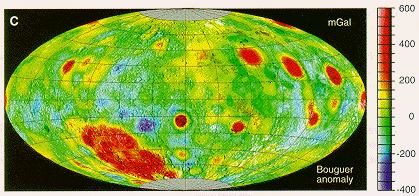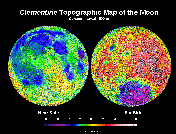NEEP602 Course Notes (Fall 1997)
Resources from Space
Lecture #10: What does the Moon tell us about the Earth?
Evolution of the Moon: The Apollo Model
Visuals
Slides illustrating the phases of lunar evolution and providing reconstructions of various periods.
Notes
Before Apollo 11, we knew a lot about the relative sequence of major events in lunar history but not the span of time each represented.
After the analysis of Apollo 17 mission data, we now had significant knowledge about the absolute ages of the stages of lunar evolution as well as details of events and processes about which we had never dreamed.
 Apollo
Model: Stages of Lunar Evolution
Apollo
Model: Stages of Lunar Evolution
Stage One: The Beginning - 4.56-4.57
eons. The Moon formed contemporaneously with the Earth.
Stage Two: The Magma Ocean - 4.5-4.4(?)
eons. Accretionary melting, due to conversion of kinetic energy
to heat and to the decay of short lived radioisotopes (e.g. 26Al), volatile
depletion due to high temperatures and low gravity, and crystal settling
and floating differentiated the outer 400-500 km of the Moon.



Major Lunar Features: End of the Magma Ocean Stage Differentiation of the Lunar Magna Ocean by Crystallization. A dunite (predominently olivine) fragment in an impact breccia - The oldest rock sampled by Apollo astronauts - about 4.6 +/-0.1 billion years old.
- Major Issue: Although probably created by the accumulation of planetismals
of varying composition, how homogenous did the Magma Ocean become as it
was stirred by continuing and increasingly energetic accretion?
- Spectroscopic analysis of Clementine and Galileo images of deep impact basins on the lunar far-side from which significant depths of crustal material have been removed suggest that the most of the present crust is more chemically heterogeneous than that exposed at the surface.
- Similar heterogeneity has been mapped by Pieters in much smaller craters (see Nozette, et al, 1994, p1844-1848) using Clementine and telescopically gathered spectra.
- Rather than suggesting that the deep impacts penetrated 50-70 km of crust to excavate lunar mantle material (P. G. Lucey et al, 1994 in Nozette, et al, 1994 and, 1996, as reported in Science News, 149, 204), these heterogeneities may reflect the mixing of Magma Ocean melt at various stages of differentiation with the still forming crust, an extremely dynamic process that was occurring as the crust formed on the still partially melted mantle.
- Regional heterogeneity in the lunar mantle, however, may have persisted as no evidence of lunar-wide convection of the Magma Ocean exists.
Stage Three: The Cratered Highlands -
4.4(?)-4.2(?) eons. Impacts of comets, asteroids, and other debris,
capable of forming craters at least 50 km in diameter, saturated the surface
of the lunar crust once it was capable of supporting itself over the residual
liquids of the magma ocean.
- Note: Oldest identified Earth crust is at least 4.0 eons old.
-



Changes to Lunar Features: End of the Cratered Highlands Stage Mapping Camera 1566: Typical farside cratered highlands Typical farside cratered highlands
- Hot and gas mobilized flows of fine impact debris radiating from Large Basin forming impact events (Stages Four and Five)?
- Pre-Mare Basalt (Stage Six) eruptions of gas mobilized initial partial melting components of the mantle with intrained crustal debris?
Stage Four: The Old Large Basins/Crustal Strengthening - 4.2(?)-3.9 eons. The Old Large Basins/Crustal Strengthening - 4.2(?)-3.9 eons. More than 30 large impact basins formed, but rapid crustal adjustment occurred followed by strengthening of that crust. This strengthening was possibly due to potassium, rare earth elements, and phosphorous-rich residual liquids (urKREEP) left over from the crystallization of the magma ocean, moving from the mantle-crust boundary, a strengthening process in and of itself, and into the crust and crystallizing into interlocking dikes within the myriad of crustal fractures.
Stage Five: The Young Large Basins -
3.9-3.8 eons. An additional 8 large impact basins formed, but the
crust was strong enough to support mass concentrations and deficiencies
indefinitely.

Changes to Major Lunar Features: End of the Young Large Basin Stage 
Mass concentrations in and mass deficiencies around Young Large Basins as shown by Bouguer gravity anomalies derived from global topography and free-air gravity models based on Clementine data (Nozette, et al., 1994, p.1841)




Clementine Topographic Map of the Moon showing the distribution of lunar basins (see figure 1 at http://cass.jsc.nasa.gov/research/clemen/clemen.html ) - Figure: Map of Nearside Young Large Basins (Nectarian System) (Wilhelms, 1987)
- Figure: Map of Farside Young Large Basins (Nectarian System) (Wilhelms, 1987)
- Figure: Map of Nearside Young Large Basins (Lower Imbrian System) (Wilhelms, 1987)
- Figure: Map of Farside Young Large Basins (Lower Imbrian System) (Wilhelms, 1987)
- Figure: Map of Nearside Young Large Basins (Upper Imbrian System) (Wilhelms, 1987)
- Figure: Map of Farside Young Large Basins (Upper Imbrian System) (Wilhelms, 1987)
- Major Issue: Lunar-wide cataclysm at 3.9 eons or not.
- Most, but not all, Apollo highland breccia samples point to a maximum age of brecciation at about 3.9 billion years - is this evidence of a lunar-wide cataclysm at that time or of a bias in the sampling to areas affected by Young Large Basin forming events?
- Major Issue: What insight does the evolution of the Moon give us about
the conditions on Earth, and possibly on Mars, as complex organic molecules
appeared, evolved to self-replication and life began?
- Carbon isotopic evidence (Mojzsis, et al, 1996) indicates that biological processes were modifying isotopic ratios on Earth at least by 3.85 billion years ago and fossil evidence indicates that complex one cell life forms were abundant by 3.5 billion years ago (Schopf, 1993), suggesting that the earliest biological evolution occurred within the space environment of lunar Stage Five or earlier.
- The implications are very strong that the surface of the Earth was exposed to the same extraordinary level of violence, transient energy release, rock pulverization, glass formation, and space contamination as was occurring on the Moon during this period.
- The surface environment of the Earth differed from that of the Moon primarily in the six time greater force of gravity and thus the presence of a water-rich fluid sphere.
- Sheet structure minerals (clays) were probably the most abundant mineral species to which organic and/or biological molecules were exposed in this initial evolutionary environment.
- Disruptions, if not restarts, of the evolutionary processes may have
occurred frequently until after 3.8 billion years ago, i.e., the end of
large basin formation on the Moon.
Text
Evolution of the Moon: The Apollo Model
Originally published by the author in American Mineralogist, v 76, 773-784, 1991.
Questions
1. What is the best evidence that the Moon was not pulled from the Earth (leaving the Pacific Ocean Basin in its wake) since life evolved on the Earth? Explain.
2. What explanation(s) can you give for the concentration of ages of samples of lunar impact breccias around 3.9 eons other than a cataclysm at that time?
3. Give a geophysical explanation for the mass concentrations (mascons) and mass deficencies in and around young large basins on the Moon and what conditions are necessary for them to persist for almost 4.0 billion years. Contrast with the Earth.
References
Alfven, H., and Arrhenius, G., 1972, Origin and Evolution of the Earth-Moon System, The Moon, v 5, 210-230.
Bowring, S.A., and Housh, T., 1005, The Earth's Early Evolution, Science, 269, 1535-1540.
Cooper, H.S.F., 1970, Moon Rocks, Dial, New York, 197p.
Head, J.W., et al, 1993, Lunar Impact Basins: New Data for the Western Limb and Far Side (Orientale and South Pole-Aitken Basins) from the First Galileo Flyby, Journal of Geophysical Research, v 98, 17149-17181.
Hartmann, W.H., 1986, Origin of the Moon, Lunar and Planetary Institute, Houston.
LPI, 1988, Workshop on Moon in Transition: Apollo 14, KREEP, and Evolved Lunar Rocks, LPI Technical Report Number 89-03,156p.
LPI, 1992, Workshop on the Physics and Chemistry of Magma Oceans from 1 Bar to 4 Mbar, LPI Technical Report Number 92-03, 79p.
Mojzsis, S.J.., et al, 1996, Nature, November 7
Nozette, S., et al, 1994, The Clementine Mission to the Moon, Science, 266, 1835-1862.
Peterson, I, 1993, A Rocky Start, Science News, 143, 190-191
Schopf, J.W., 1993, Science 260, 640.
Shoemaker, E.M., 1962, Interpretation of lunar craters, in Zdenek Kopal, editor, Physics and astronomy of the Moon, P. 283-359, Academic Press, New York.
Taylor, S.R., 1982, Planetary Science: A Lunar Perspective, Lunar and Planetary Institute, Houston, 481p.
Wilhelms, D. E., 1987, The Geologic History of the Moon, U.S. Geological Survey Professional Paper 1348, U.S. Government Printing Office, Washington, 302p.
 |
|
University of Wisconsin Fusion Technology Institute · 439 Engineering Research Building · 1500 Engineering Drive · Madison WI 53706-1609 · Telephone: (608) 263-2352 · Fax: (608) 263-4499 · Email: fti@engr.wisc.edu |
Copyright © 2003 The Board of
Regents of the University of Wisconsin System.
For feedback or accessibility issues, contact
web@fti.neep.wisc.edu.
|
 Pre-Apollo
Model for Lunar Evolution
Pre-Apollo
Model for Lunar Evolution 








